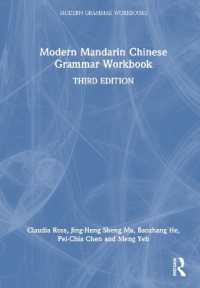- ホーム
- > 洋書
- > 英文書
- > History / World
Full Description
This in-depth exploration of emotions in the ancient Near East illuminates the rich and complex worlds of feelings encompassed within the literary and material remains of this remarkable region, home to many of the world's earliest cities and empires, and lays critical foundations for future study.
Thirty-four chapters by leading international scholars, including philologists, art historians, and archaeologists, examine the ways in which emotions were conceived, experienced, and expressed by the peoples of the ancient Near East, with particular attention to Mesopotamia, Anatolia, and the kingdom of Ugarit, from the Late Uruk through to the Neo-Babylonian Period (ca. 3300-539 BCE). The volume is divided into two parts: the first addressing theoretical and methodological issues through thematic analyses and the second encompassing corpus-based approaches to specific emotions. Part I addresses emotions and history, defining the terms, materialization and material remains, kings and the state, and engaging the gods. Part II explores happiness and joy; fear, terror, and awe; sadness, grief, and depression; contempt, disgust, and shame; anger and hate; envy and jealousy; love, affection, and admiration; and pity, empathy, and compassion. Numerous sub-themes threading through the volume explore such topics as emotional expression and suppression in relation to social status, gender, the body, and particular social and spatial conditions or material contexts.
The Routledge Handbook of Emotions in the Ancient Near East is an invaluable and accessible resource for Near Eastern studies and adjacent fields, including Classical, Biblical, and medieval studies, and a must-read for scholars, students, and others interested in the history and cross-cultural study of emotions.
Contents
Introduction: Emotions in the Ancient Near East: Foundations for a Developing Field of Study, Karen Sonik and Ulrike Steinert; Part I: Theoretical and Thematic Approaches and Methods; I. Emotions and History; 1. The Emotions of Dead Civilizations: "Come, Tell Me How You Lived", Karen Sonik; 2. Emotion and the Body: Embodiment, Conceptual Metaphor, and Linguistic Encoding of Emotions in Akkadian, Ulrike Steinert; 3. Digital Approaches to Analyzing and Translating Emotion: What is Love?, Tero Alstola, Heidi Jauhiainen, Saana Svärd, Aleksi Sahala, and Krister Lindén; II. Defining the Terms; 4. Sumerian Emotion Terms, Margaret Jaques; 5. Akkadian Emotion Terms, Janine Wende; 6. Hittite Emotion Terms, Gary Beckman; 7. Ugaritic Emotion Terms, Andrew R. Burlingame; III. Materialization and Material Remains; 8. Emotions and Archaeology in Ancient Mesopotamia, Susan Pollock; 9. Emotions and Musical Performance, Dahlia Shehata; 10. Emotions and Body Language: The Expression of Emotions in Visual Art, Karen Sonik; IV. Kings and the State; 11. Emotions and Assyrian Kingship, Johannes Bach; 12. Emotions and Hittite Kingship: Feeling Like a King, Amir Gilan and Romina Della Casa; 13. Emotions and the Brotherhood of Kings: Affection in the Amarna Letters, Amanda H. Podany; V. Engaging the Gods; 14. Emotions and Emesal Laments: Motivations, Performance, and Management, Uri Gabbay; 15. Emotions and Ritual Laments: The Affective Function of Beer in Mesopotamia, Gösta Gabriel; 16. Emotions and Religion: Ritual Performance in Mesopotamia, Beate Pongratz-Leisten; 17. Emotions and Hittite Prayers, Lidewij van de Peut; Part II: Corpus-Based Approaches; I. Happiness and Joy; 18. Joy and Happiness in Mesopotamian Royal Inscriptions, Nathan Morello; 19. Joy and Happiness in Hittite Texts, Alice Mouton; II. Fear, Terror, and Awe; 20. Awe as Entangled Emotion: Prosociality, Collective Action, and Aesthetics in the Sumerian Gilgamesh Narratives, Karen Sonik; 21. Fear and Terror in Assyrian Palace Reliefs, Dominik Bonatz; III. Sadness, Grief, and Depression; 22. Grief and Sadness in the Sumerian Gilgamesh Narratives, Alhena Gadotti; 23. Grief and Sadness in Akkadian Texts, Irene Sibbing-Plantholt; 24. Grief and Sadness in Ugaritic Texts, Joseph Lam, IV. Contempt, Disgust, and Shame; 25. Contempt and Related Emotions in Hittite and Akkadian Literary Texts, Ilan Peled; 26. Shaming the Enemy in Assyrian Palace Reliefs and Royal Inscriptions, Davide Nadali; V. Anger and Hate; 27. Anger and Hatred in Neo-Assyrian and Neo-Babylonian Royal Inscriptions, Hanspeter Schaudig; 28. Anger and Hatred in Hittite Texts, Sylvie Vanséveren; VI. Envy and Jealousy; 29. Envy and Jealousy in Magico-Medical Texts, Elyze Zomer; VII. Love, Affection, and Admiration; 30. Love and Desire in Sumerian Texts, M. Erica Couto-Ferreira; 31. Love and Kindness in the Assyrian State, Frederick Mario Fales; 32. Love and Affection in Hittite Texts, Birgit Christiansen; VIII. Pity, Empathy, and Compassion; 33. Compassion, Pity, and Empathy in Sumerian Sources, Dina Katz; 34. Pity and Suffering in Old Babylonian Akkadian Sources, Nele Ziegler.








